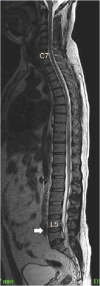A Whole Spine MRI Based Study of the Prevalence, Associated Disc Degeneration and Anatomical Correlations of Lumbosacral Transitional Vertebra
- PMID: 36867110
- PMCID: PMC11418674
- DOI: 10.1177/21925682231161559
A Whole Spine MRI Based Study of the Prevalence, Associated Disc Degeneration and Anatomical Correlations of Lumbosacral Transitional Vertebra
Abstract
Study design: Retrospective cohort study.
Objective: Lumbosacral transitional vertebra (LSTV) results in numerical alterations of the lumbar and sacral segments. Literature concerning true prevalence, associated disc degeneration, and variation in numerous anatomical landmarks concerning LSTV is lacking.
Methods: This is a retrospective cohort study. The prevalence of LSTV was determined in whole spine MRIs of 2011 poly-trauma patients. LSTV was identified as sacralization (LSTV-S) or lumbarization (LSTV-L) and further sub-classified into Castellvi's and O'Driscoll's type respectively. Disc degeneration was evaluated using Pfirmann grading. Variation in important anatomical landmarks was also analysed.
Results: Prevalence of LSTV was 11.6% with 82% having LSTV-S. Castellvi's type 2A and O'Driscoll type 4 were the commonest sub-types. LSTV patients demonstrated considerably advanced disc degeneration. The median termination level of conus medullaris (TLCM) in non- LSTV and LSTV-L groups was at middle L1 (48.1% and 40.2%) while in the LSTV-S group, it was at upper L1 (47.2%). The median level of right renal artery (RRA) in non- LSTV patients was at middle L1 in 40.0% of individuals while in the LSTV-L and LSTV-S groups, it was at upper L1 level in 35.2% and 56.2% respectively. The median level of abdominal aortic bifurcation (AA) in non-LSTV and LSTV-S patients was at middle L4 in 83.3% and 52.04% respectively. However, in the LSTV-L group, the most common level was middle L5 (53.6%).
Conclusion: The overall prevalence of LSTV was 11.6%, with sacralization accounting for more than 80%. LSTV is associated with disc degeneration and a variation in the levels of important anatomical landmarks.
Keywords: O’Driscoll’s classification; abdominal aorta bifurcation; castellvi’s classification; conus medullaris termination; disc degeneration; lumbosacral transitional vertebra; prevalence; right renal artery.
Conflict of interest statement
Declaration of Conflicting InterestsThe author(s) declared no potential conflicts of interest with respect to the research, authorship, and/or publication of this article.
Figures
Similar articles
-
Prevalence of lumbosacral transitional vertebra among 4816 consecutive patients with low back pain: A computed tomography, magnetic resonance imaging, and plain radiographic study with novel classification schema.J Craniovertebr Junction Spine. 2023 Jan-Mar;14(1):35-43. doi: 10.4103/jcvjs.jcvjs_149_22. Epub 2023 Mar 13. J Craniovertebr Junction Spine. 2023. PMID: 37213577 Free PMC article.
-
Lumbosacral transition vertebra: prevalence and its significance.Asian Spine J. 2014 Feb;8(1):51-8. doi: 10.4184/asj.2014.8.1.51. Epub 2014 Feb 6. Asian Spine J. 2014. PMID: 24596605 Free PMC article.
-
Lumbosacral Transitional Vertebrae Cause Spinal Level Misconception in Surgeries for Degenerative Lumbar Spine Disorders.Tohoku J Exp Med. 2017 Jul;242(3):223-228. doi: 10.1620/tjem.242.223. Tohoku J Exp Med. 2017. PMID: 28717058
-
Risks Associated with Surgical Management of Lumbosacral Transitional Vertebrae: Systematic Review of Surgical Considerations and Illustrative Case.World Neurosurg. 2024 Jun;186:e54-e64. doi: 10.1016/j.wneu.2024.02.033. Epub 2024 Feb 11. World Neurosurg. 2024. PMID: 38350597
-
Partial Lumbosacral Transitional Vertebra: A case of unilateral sacralization and its embryological and clinical implications.Kathmandu Univ Med J (KUMJ). 2019 Jul-Sept.;17(67):245-247. Kathmandu Univ Med J (KUMJ). 2019. PMID: 33305756 Review.
Cited by
-
Frequency of lumbosacral transitional vertebra and its relationship with disease related parameters of patients with axial spondyloarthritis.J Rheum Dis. 2025 Jul 1;32(3):190-197. doi: 10.4078/jrd.2025.0013. Epub 2025 Apr 30. J Rheum Dis. 2025. PMID: 40584768 Free PMC article.
References
LinkOut - more resources
Full Text Sources




